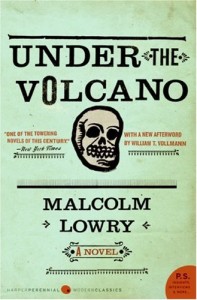Lowry, Malcolm. (1947). Under the Volcano. New York: Harper & Row.
It’s intimidating to read an iconic novel like this, one universally acclaimed as a “towering achievement in 20th century literature,” and so forth. It’s as if your mind must be made up before you begin. Nevertheless, except for the hyperbolic cover blurbs, I was ignorant of the book and its author (and also of the 1984 film by John Huston), and after reading, my opinion is mixed.
The book portrays the mind of Geoffry Firmin, a self-destructive alcoholic, on a single day, the Day of the Dead, in a small town near Mexico City. He is the British Consul there and the time is 1938, just prior to the outbreak of WWII. Civilization is on the brink of destruction and so is Firmin.
Much is made of Lowry’s use of such metaphors. For example, the novel dwells repeatedly on the only movie playing in town, “The Hands of Orlac,” a 1935 horror picture of woman (named Yvonne, same as Firmin’s ex-wife!) who seeks help for her brother whose hands have been injured. A mad surgeon replaces the hands with those of a carnival knife-thrower, with the result that the brother cannot help but kill everyone around him with knives. Nevertheless, Yvonne inexplicably continues to love her deranged brother through it all. The self-destructive knives represent Firmin’s self-destructive alcoholism, get it?
Another main character in the novel is the landscape. The town is dwarfed by two smoldering volcanoes, and a deep, hellish canyon runs through the center. This represents the relationship between Firmin and Yvonne. The scenery is portrayed in fine detail, and one does have a strong sense (all five senses) of place. That is a writerly achievement, although for a modern reader, page after page of expositional description is not as thrilling as it might have been in an age before mass media’s granting of universal access to every corner of the planet.
As Firmin drinks his life away, he is joined by Yvonne, who had left him because of his drunkenness. While absent, she sent dozens of passionate and sentimental pleas to rekindle their love and start over. But he never read any of them. She arrives, and she and Firmin declare their passionate love for each other, but neither seems to mean it. Firmin is always drunk, so you can’t believe a word he says, but we get the sense that he is afraid. That’s why he didn’t read the letters. Yvonne, for her part, seems to want the past and a future with Firmin, but not the present. This dynamic is the heart of the novel.
There is no plot. The characters walk around, drink, smoke, take bus rides, visit festivals and bars. Eventually Firmin is killed in a bar fight. The point of the novel is not what happens, or doesn’t happen, but rather, their streams of consciousness, especially Firmin’s. His consciousness is interesting because he is erudite and voluble, so waxes poetic on multiple topics from classical literature to contemporary politics, but he is uninteresting because he is always drunk. Long sequences portraying his hallucinations and wild associations are writerly tour-de-force, but ultimately meaningless ravings. What Firmin does not do is confront his motivation and feelings for Yvonne, and he avoids thinking about the meaning and consequence of his addiction. All he would have to do is choose love. Why can’t he act? He is afraid of life, and of himself, but we never get a clear picture of what tyrannizes him. Maybe he doesn’t know, but then, why should we care either, why should Yvonne, why should anyone?
Much is made of the fact that the novel is quasi-autobiographical and that Lowry suffered (and died) from alcoholism, but such facts do not justify or explain the novel, which must stand on its own feet as an artistic product. I guess we can assume, at least, that Firmin’s alcoholic mentality resembles one person’s actual experience.
Lowry’s language is creative and poetic throughout, and that is a pleasure, but since the novel lacks overall dramatic drive or characterological development, the endless pages of lyrical description, for me, quickly devolved to mere wordsmithing. The long, extended stream of consciousness descriptions were mildly interesting, but I would rather get to know a character through action, dialog, and circumstance, rather than by access to detailed contents of consciousness, which, in this case, were idiosyncratic, mundane, and un-illuminating.

